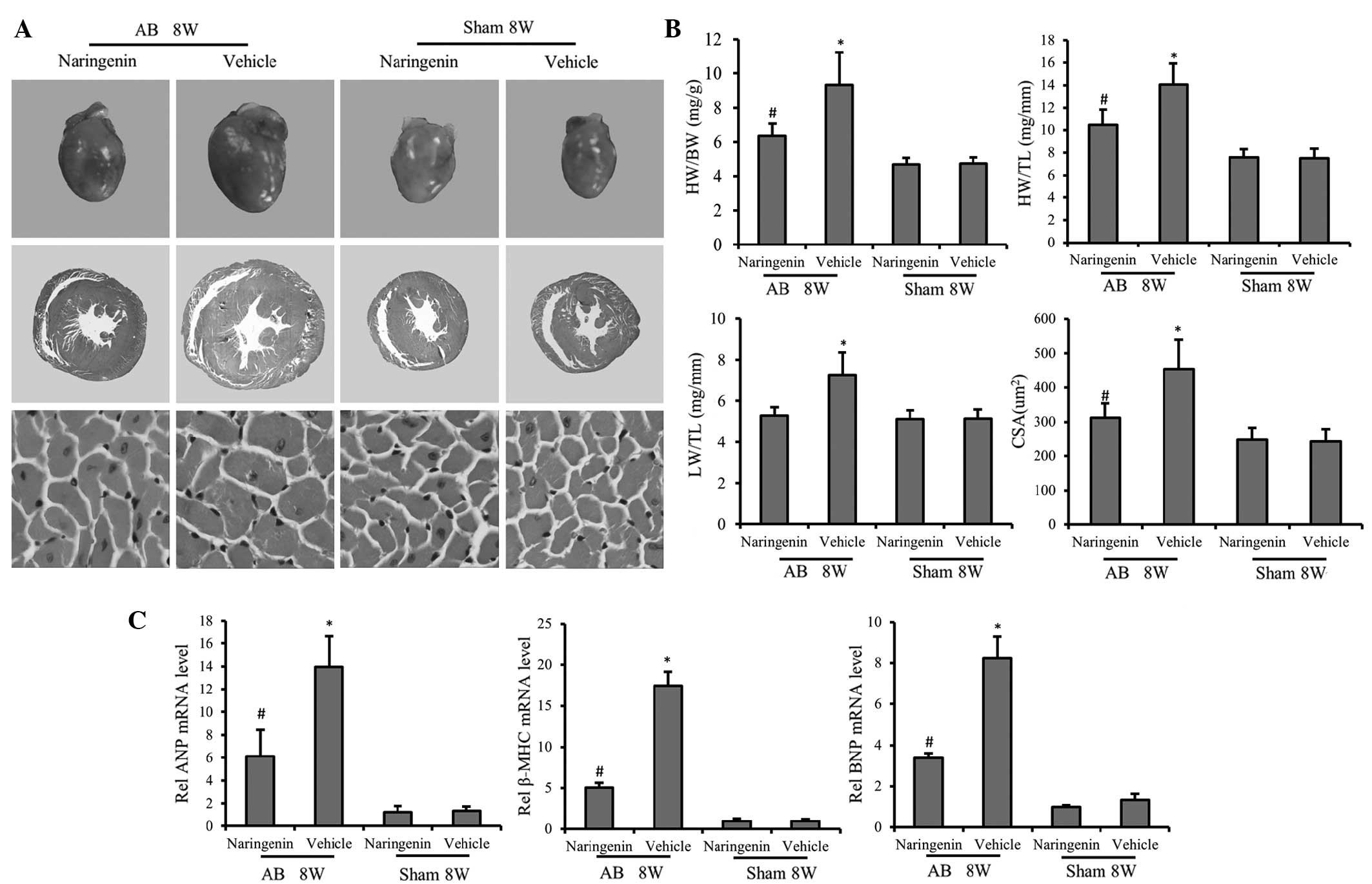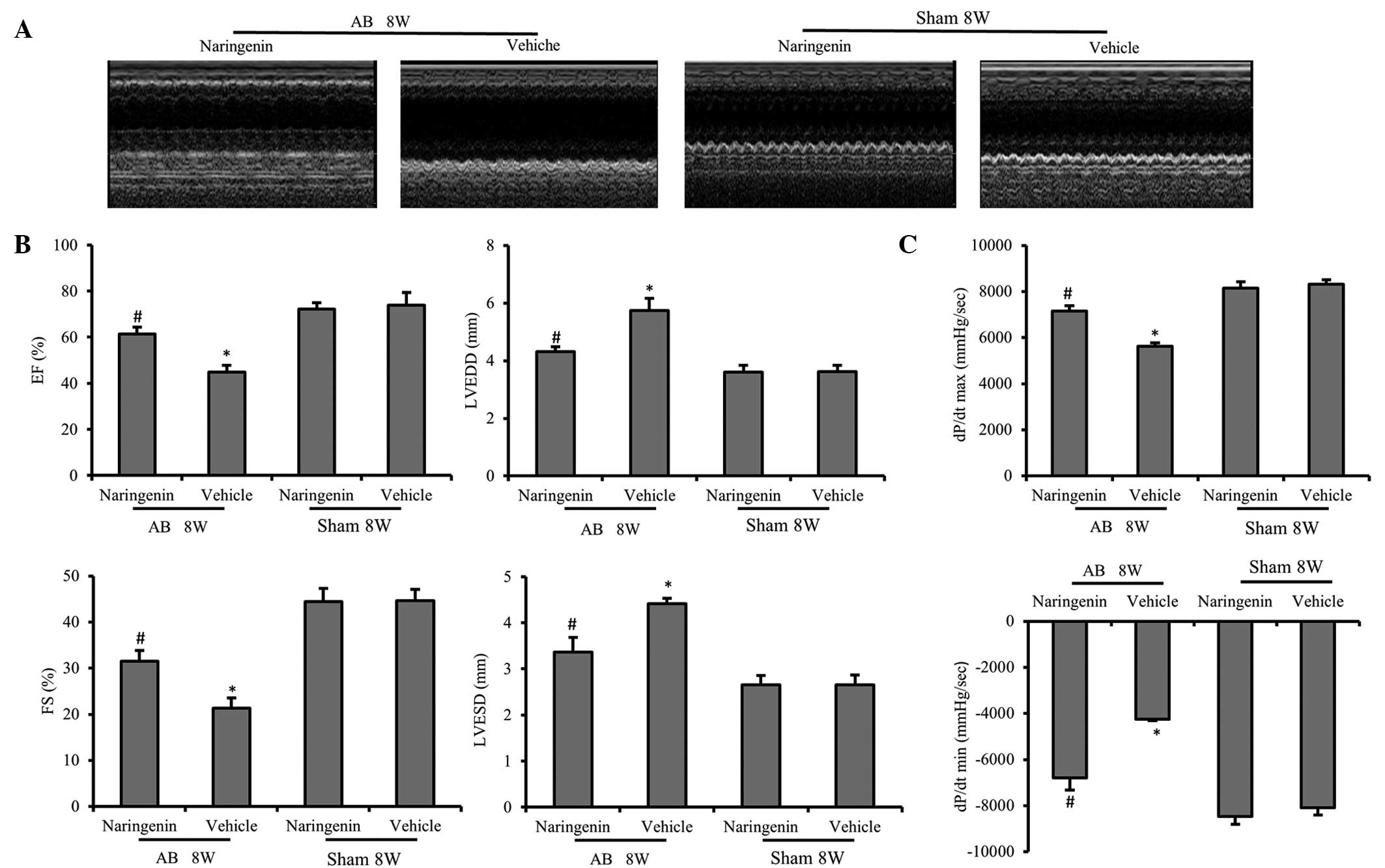|
1
|
Balakumar P and Jagadeesh G: Multifarious
molecular signaling cascades of cardiac hypertrophy: Can the muddy
waters be cleared? Pharmacol Res. 62:365–383. 2010. View Article : Google Scholar : PubMed/NCBI
|
|
2
|
Gjesdal O, Bluemke DA and Lima JA: Cardiac
remodeling at the population level-risk factors, screening and
outcomes. Nat Rev Cardiol. 8:673–685. 2011. View Article : Google Scholar : PubMed/NCBI
|
|
3
|
Hellawell JL and Margulies KB: Myocardial
reverse remodeling. Cardiovasc Ther. 30:172–181. 2012. View Article : Google Scholar : PubMed/NCBI
|
|
4
|
van Berlo JH, Maillet M and Molkentin JD:
Signaling effectors underlying pathologic growth and remodeling of
the heart. J Clin Invest. 123:37–45. 2013. View Article : Google Scholar : PubMed/NCBI
|
|
5
|
Yuan Y, Zong J, Zhou H, Bian ZY, Deng W,
Dai J, Gan HW, Yang Z, Li H and Tang QZ: Puerarin attenuates
pressure overload-induced cardiac hypertrophy. J Cardiol. 63:73–81.
2014. View Article : Google Scholar : PubMed/NCBI
|
|
6
|
Middleton E Jr and Kandaswami C: Effects
of flavonoids on immune and inflammatory cell functions. Biochem
Pharmacol. 43:1167–1169. 1992. View Article : Google Scholar : PubMed/NCBI
|
|
7
|
Oshipura KJ, Hu FB, Manson JE, Stampfer
MJ, Rimm EB, Speizer FE, Colditz G, Ascherio A, Rosner B,
Spiegelman D and Willett WC: The effect of fruit and vegetable
intake on risk for coronary heart disease. Ann Intern Med.
134:1106–1114. 2001. View Article : Google Scholar : PubMed/NCBI
|
|
8
|
Dauchet L, Ferrières J, Arveiler D,
Yarnell JW, Gey F, Ducimetière P, Ruidavets JB, Haas B, Evans A,
Bingham A, et al: Frequency of fruit and vegetable consumption and
coronary heart disease in France and Northern Ireland: The PRIME
study. Br J Nutr. 92:963–972. 2004. View Article : Google Scholar : PubMed/NCBI
|
|
9
|
Saponara S, Testai L, Iozzi D, Martinotti
E, Martelli A, Chericoni S, Sgaragli G, Fusi F and Calderone V:
(+/−)-Naringenin as large conductance Ca(2+)-activated K+ (BKCa)
channel opener in vascular smooth muscle cells. Br J Pharmacol.
149:1013–1021. 2006. View Article : Google Scholar : PubMed/NCBI
|
|
10
|
Testai L, Martelli A, Marino A,
D'Antongiovanni V, Ciregia F, Giusti L, Lucacchini A, Chericoni S,
Breschi MC and Calderone V: The activation of mitochondrial BK
potassium channels contributes to the protective effects of
naringenin against myocardial ischemia/reperfusion injury. Biochem
Pharmacol. 85:1634–1643. 2013. View Article : Google Scholar : PubMed/NCBI
|
|
11
|
Yan L, Huang H, Tang QZ, Zhu LH, Wang L,
Liu C, Bian ZY and Li H: Breviscapine protects against cardiac
hypertrophy through blocking PKC-alpha-dependent signaling. J Cell
Biochem. 109:1158–1171. 2010.PubMed/NCBI
|
|
12
|
Zhou H, Bian ZY, Zong J, Deng W, Yan L,
Shen DF, Guo H, Dai J, Yuan Y, Zhang R, et al: Stem cell antigen 1
protects against cardiac hypertrophy and fibrosis after pressure
overload. Hypertension. 60:802–809. 2012. View Article : Google Scholar : PubMed/NCBI
|
|
13
|
Carreño JE, Apablaza F, Ocaranza MP and
Jalil JE: Cardiac hypertrophy: Molecular and cellular events. Rev
Esp Cardiol. 59:473–486. 2006.(In Spanish). View Article : Google Scholar : PubMed/NCBI
|
|
14
|
Frey N and Olson EN: Cardiac hypertrophy:
The good, the bad and the ugly. Annu Rev Physiol. 65:45–79. 2003.
View Article : Google Scholar : PubMed/NCBI
|
|
15
|
Lorenz K, Schmitt JP, Vidal M and Lohse
MJ: Cardiac hypertrophy: Targeting Raf/MEK/ERK1/2-signaling. Int J
Biochem Cell Biol. 41:2351–2355. 2009. View Article : Google Scholar : PubMed/NCBI
|
|
16
|
Lorenz K, Schmitt JP, Schmitteckert EM and
Lohse MJ: A new type of ERK1/2 autophosphorylation causes cardiac
hypertrophy. Nat Med. 15:75–85. 2009. View
Article : Google Scholar : PubMed/NCBI
|
|
17
|
Paul A, Wilson S, Belham CM, Robinson CJ,
Scott PH, Gould GW and Plevin R: Stress-activated protein kinases:
Activation, regulation and function. Cell Signal. 9:403–410. 1997.
View Article : Google Scholar : PubMed/NCBI
|
|
18
|
Sopontammarak S, Aliharoob A, Ocampo C,
Arcilla RA, Gupta MP and Gupta M: Mitogen-activated protein kinases
(p38 and c-Jun NH2-terminal kinase) are differentially regulated
during cardiac volume and pressure overload hypertrophy. Cell
Biochem Biophys. 43:61–76. 2005. View Article : Google Scholar : PubMed/NCBI
|
|
19
|
Lei B, Chess DJ, Keung W, O'Shea KM,
Lopaschuk GD and Stanley WC: Transient activation of p38 MAP kinase
and up-regulation of Pim-1 kinase in cardiac hypertrophy despite no
activation of AMPK. J Mol Cell Cardiol. 45:404–410. 2008.
View Article : Google Scholar : PubMed/NCBI
|
|
20
|
Vanhaesebroeck B, Guillermet-Guibert J,
Graupera M and Bilanges B: The emerging mechanisms of
isoform-specific PI3K signalling. Nat Rev Mol Cell Biol.
11:329–341. 2010. View
Article : Google Scholar : PubMed/NCBI
|
|
21
|
Chaanine AH and Hajjar RJ: AKT signalling
in the failing heart. Eur J Heart Fail. 13:825–829. 2011.
View Article : Google Scholar : PubMed/NCBI
|
|
22
|
Badorff C, Ruetten H, Mueller S, Stahmer
M, Gehring D, Jung F, Ihling C, Zeiher AM and Dimmeler S: Fas
receptor signaling inhibits glycogen synthase kinase 3 beta and
induces cardiac hypertrophy following pressure overload. J Clin
Invest. 109:373–381. 2002. View
Article : Google Scholar : PubMed/NCBI
|
|
23
|
Haq S, Choukroun G, Kang ZB, Ranu H,
Matsui T, Rosenzweig A, Molkentin JD, Alessandrini A, Woodgett J,
Hajjar R, et al: Glycogen synthase kinase-3beta is a negative
regulator of cardiomyocyte hypertrophy. J Cell Biol. 151:117–130.
2000. View Article : Google Scholar : PubMed/NCBI
|
|
24
|
Creemers EE and Pinto YM: Molecular
mechanisms that control interstitial fibrosis in the
pressure-overloaded heart. Cardiovasc Res. 89:265–272. 2011.
View Article : Google Scholar : PubMed/NCBI
|
|
25
|
Hutchinson KR, Guggilam A, Cismowski MJ,
Galantowicz ML, West TA, Stewart JA Jr, Zhang X, Lord KC and
Lucchesi PA: Temporal pattern of left ventricular structural and
functional remodeling following reversal of volume overload heart
failure. J Appl Physio. 111:1778–1788. 2011. View Article : Google Scholar
|














